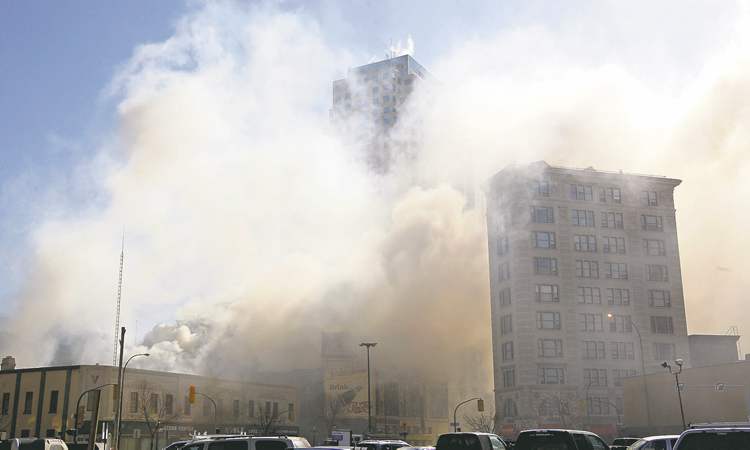135 years up in smoke
Blog of the week: West End Dumplings
Advertisement
Read this article for free:
or
Already have an account? Log in here »
To continue reading, please subscribe:
Monthly Digital Subscription
$0 for the first 4 weeks*
- Enjoy unlimited reading on winnipegfreepress.com
- Read the E-Edition, our digital replica newspaper
- Access News Break, our award-winning app
- Play interactive puzzles
*No charge for 4 weeks then price increases to the regular rate of $19.00 plus GST every four weeks. Offer available to new and qualified returning subscribers only. Cancel any time.
Monthly Digital Subscription
$4.75/week*
- Enjoy unlimited reading on winnipegfreepress.com
- Read the E-Edition, our digital replica newspaper
- Access News Break, our award-winning app
- Play interactive puzzles
*Billed as $19 plus GST every four weeks. Cancel any time.
To continue reading, please subscribe:
Add Free Press access to your Brandon Sun subscription for only an additional
$1 for the first 4 weeks*
*Your next subscription payment will increase by $1.00 and you will be charged $16.99 plus GST for four weeks. After four weeks, your payment will increase to $23.99 plus GST every four weeks.
Read unlimited articles for free today:
or
Already have an account? Log in here »
Hey there, time traveller!
This article was published 06/05/2012 (4969 days ago), so information in it may no longer be current.
It’s sad that the Albert Street Business Block at 44 Albert St. went up in flames (April 19), taking two businesses with it. You may remember that it was part of an on again/off again demolition debate between 2005 and 2008 when the owner of the derelict St. Charles Hotel wanted to tear it down to create a surface parking lot.
Despite its low density and humble appearance, 44 Albert managed to stick around for 135 years while the city grew up around it.
According to the city’s historic building report, the house portion was built in 1877 for John LeCappellain at 8 Albert St. He was a one-time senior employee of Ashdown’s Hardware, but that year went into business for himself when he bought out McKenney’s Hardware Store.

It’s likely that he bought Henry McKenney’s business from his son John. Henry is considered the founder of Portage and Main as he chose to establish his business off the beaten track at the intersection of two cart trails that would soon become Winnipeg’s most famous intersection.
At the time, the area surrounding what we now call Old Market Square was one of Winnipeg’s original residential neighbourhoods. The last remnant of this residential past is now Kelly House on Adelaide Street, built five years later than LeCappellain’s.
Despite being in the middle of a boom town, these were still frontier years. There was no running water yet and it would take another 15 years before the street was paved.
Other houses on Albert, especially numbers 6 and 7, rented out rooms on a regular basis. It appears that LeCappellain’s house did not. They did have someone staying in 1884 though.
A Sgt. Back of the Winnipeg troop of the cavalry was a guest. New recruits were invited to come by the house if they wanted to sign up for service. Three weeks after that article appeared, a letter to the editor appeared in the Free Press complaining about a horse being allowed to run free on Albert Street near Notre Dame. I wonder if the two are connected and cavalryman Back caused strained relations between LeCappellain and a neighbour?
In 1905 the house got a new address (44) and it became a commercial building. Newspaper L’echo du Manitoba was based there for a few months before it shut down. It then became home to Fred Hilson’s Auction house.
Despite being a stone’s throw from Portage and Main, the portion of Albert Street near Notre Dame was a late bloomer.
It wasn’t until 1913 that the homes and plywood, single-storey commercial buildings began to make way for the type of commercial development that had been happening all around it for nearly two decades. That year the Hotel St. Charles and Royal Albert Arms opened on each side of 44 Albert and the Lindsay Building and Electric Railway Chambers soared above.
In 1918 the building was sold as prime commercial land. The ad didn’t even mention what was on the property. In 1924 when a four-unit commercial addition was built on the south end of the property, the house was incorporated into the new structure.
The lack of pressure for new commercial development in the area left 44 Albert relatively untouched right through until the 2000s. In the 1960s, cities began to rediscover their historic districts. Montreal, Toronto and Vancouver found that a rejuvenation of these areas made good economic sense.
In the mid-1970s the Old Market Square Association was created to lobby for improvements what we now call the Exchange District. It began at the city level with basic improvements such as streetscaping and in 1976 the Heritage Canada Trust announced a $500,000 grant to help purchase and restore significant buildings. Because the area was so large it was decided that Albert Street would be the focus.
Although 44 Albert Street had been a recent target for demolition, some arguing that it was an inconsequential part of the streetscape, at the time of the fire it boasted two retail businesses. The hotels on each side of it, both of which have been subjects of high-profile redevelopment announcements, continue to sit vacant.

Our newsroom depends on a growing audience of readers to power our journalism. If you are not a paid reader, please consider becoming a subscriber.
Our newsroom depends on its audience of readers to power our journalism. Thank you for your support.



